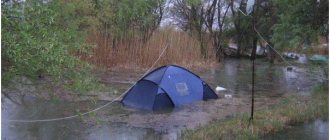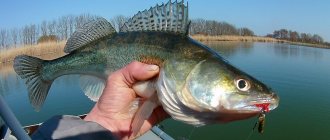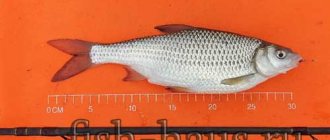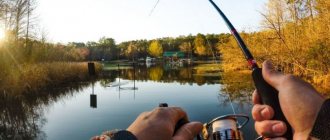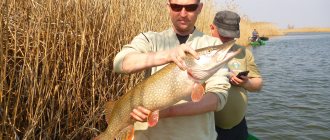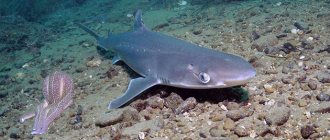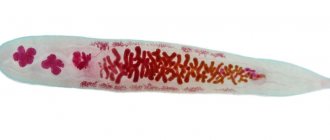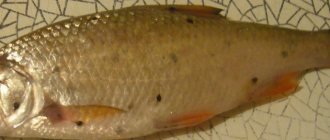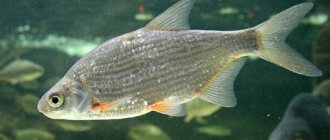River system [edit]
Main article: Volga River
The Volga River is the longest river in Europe (3700 km); its length within the Astrakhan region is more than 400 km.
In the Astrakhan region, the Volga, in an arid climate, does not receive a single tributary. Near the city of Volzhsky, a large branch separates from the Volga to the east - Akhtuba, which throughout its entire length flows parallel to the main channel, moving away from it at a distance of 7 to 30 km and forming the vast Volga-Akhtuba floodplain. The length of the Volga-Akhtuba floodplain from the beginning to the top of the Volga delta is about 450 km; Floodplain area is about 7,500 sq. km.
Main article: Volga-Akhtuba floodplain
The Volga-Akhtuba floodplain occupies a low-lying area that is flooded with river waters during flood periods. The right bank of the Volga is steep, actively eroded and eroded, the left bank is gentle, smoothly turning into an island floodplain surface covered with lush meadow and tree vegetation.
Main article: Volga Delta
The Volga Delta is one of the largest deltas in the world; its area is 11,000 square meters. km. The Volga delta looks like an almost regular triangle. The top of the modern delta is the junction of separation from the Volga River and the large left delta branch of Buzan, 50 km above the city of Astrakhan.[1]
Lakes of the Astrakhan region
Fishing on lakes in the Astrakhan region is not of interest, since they are mostly swampy, shallow bodies of salt water. Here are a few such interesting lakes in Astrakhan:
Baskunchak
- a fairly large lake that is not suitable for fishing. Its size is 18 km long and 13 km wide. The water here is very salty; if you swim in the lake, the water, due to the concentration of salt, will constantly keep the body on the surface. You can get here by minibus from the city of Akhtubinsk. Salt is also mined here.
Greater Chada
— the lake is located in the Limansky district, has small dimensions of 5.6 × 2.6 km, and swampy shores. The depth of the reservoir is on average just over one meter.
Tinaki
- another salt lake, only smaller in size, 0.9 hectares, located in the Narimanovsky district. The banks of the reservoir are swampy and covered with a white coating of brine (a highly concentrated salt solution). The water is pinkish in summer.
Lakes [edit]
The lakes of the Astrakhan region are represented by a large number of reservoirs, varying in size, hydrological and hydrochemical regimes and origin. Based on their origin, they are divided into tectonic, dammed and mixed, and based on their chemical composition - into fresh and salty.
Main article: Baskunchak
Lake Baskunchak belongs to the tectonic type. It is a trough, the subsidence of which is compensated by sedimentation mainly in the form of salt strata. In plan, the lake has a regular shape with a general orientation in the north-west direction. The greatest length of the lake is 18 km, the width ranges from 6-9 km, the total area is 106 sq. km, the salt surface is 21.3 m. The salinity of brine in the lake reaches 300 ppm.
A large number of lakes are located in the Volga delta. They have a local name - ilmeni. Their distribution in the delta is uneven. In its western and eastern parts (zones of western and eastern substeppe ilmens), ilmens occupy, respectively, about 31% (5907 sq. km) and 14% (2644 sq. km) of the area of the entire delta. The minimum number of lake objects is typical for the central region of the delta.
The ilmens are fed mainly during the flood period, through eriks connecting the ilmens with larger delta watercourses. Only a small part of the ilmens retain connections with watercourses
Fishing forecast in the Astrakhan region
| Weather forecast and fish bite | Calendar, from 01-07-2021 to 04-07-2021 | |||||||||||
| Thu | PT | SB | VS | |||||||||
| Times of Day | Evening | Night | Morning | Day | Evening | Night | Morning | Day | Evening | Night | Morning | Day |
| Cloudiness, precipitation | Clear | Partly cloudy | Partly cloudy | Clear | Clear | Clear | Partly cloudy | Partly cloudy | Partly cloudy | Partly cloudy | Partly cloudy | Partly cloudy |
| Temperature °C | 34 | 29 | 26 | 33 | 36 | 30 | 27 | 35 | 38 | 30 | 27 | 36 |
| Pressure, mm. | 759 | 758 | 756 | 756 | 755 | 755 | 755 | 755 | 753 | 753 | 754 | 754 |
| Direction, | West wind | Wind southwest | Wind northwest | Wind northwest | Wind northwest | Wind northeast | Wind northwest | Wind northeast | North wind | Wind southwest | Wind northeast | East wind |
| wind speed | 4 m/s | 3 m/s | 2 m/s | 3 m/s | 4 m/s | 1 m/s | 2 m/s | 2 m/s | 3 m/s | 3 m/s | 3 m/s | 5 m/s |
| According to the forecast, they bite on: corn, potatoes, peas, boilies Carp | 80% | 80% | 90% | 70% | 80% | 65% | 90% | 55% | 65% | 80% | 75% | 55% |
| According to the forecast, they will bite on: boilies, corn, potatoes, peas, crayfish Carp | 60% | 70% | 75% | 65% | 60% | 55% | 75% | 50% | 45% | 70% | 60% | 50% |
| According to the forecast, the fish will bite on: live bait, spinners, wobblers, and silicone baits Pike | 50% | 10% | 60% | 45% | 50% | 0% | 60% | 30% | 35% | 10% | 45% | 30% |
| According to the forecast, they will bite on: worm, leech, small baitfish, spinners, wobblers, silicone Perch | 75% | 0% | 85% | 65% | 75% | 0% | 85% | 50% | 60% | 0% | 70% | 50% |
| According to the forecast, they bite on: live bait, wobblers, silicone, foam fish Zander | 95% | 80% | 90% | 65% | 95% | 65% | 90% | 50% | 80% | 80% | 75% | 50% |
| According to the forecast, the fish will bite on: spinners, wobblers, silicone, grasshoppers, streamers Asp | 80% | 30% | 90% | 65% | 80% | 10% | 90% | 45% | 60% | 30% | 70% | 45% |
| Bait: worm, live bait, mole cricket, silicone, frog Som | 60% | 70% | 55% | 35% | 60% | 90% | 55% | 55% | 80% | 70% | 75% | 55% |
Groundwater [edit]
Groundwater is widespread throughout the region and lies at different depths. They are divided into ground and underground (interlayer).
Groundwater is confined to the first impermeable horizon and lies at a depth of 0.5 to 50 m. These waters lie closest to the surface in riverine areas and low-lying areas of the relief. They are quite highly mineralized, contaminated and are practically not used. At the same time, in the area of Lake Baskunchak, the Khazar waters are fresh and are the source of water supply for the village of Nizhny Baskunchak.
Interstratal waters are found in aquifers between layers of impermeable rocks. For the most part, interstratal waters are characterized by increased mineralization and are recommended for use for medicinal purposes.
Groundwater in some areas of the region contains high industrial concentrations of iodine and bromine (depth of occurrence - 300-350 m). There are no projects for the industrial development of such deposits yet.[1]
The longest rivers of the Astrakhan region
List of the largest rivers flowing through the region.
Volga
The main river of Russia is the most important water artery of the Astrakhan region. In fact, all other rivers of the region are its branches and numerous river channels. In the region, the Volga does not receive a single tributary and flows into the Caspian Sea, forming one of the most extensive deltas in the world. Its area is 11,000 km². On the Volga, a little above the delta, Astrakhan is located.
The length of the river is 3530 km, in the Astrakhan region – more than 400 km.
Akhtuba
The left branch of the Volga separates from it in the satellite city of Volgograd, Volzhsky. It flows along the Volga, the territory between the two rivers is called the Volga-Akhtuba floodplain. There are many nature protection zones, water meadows, and farmland. The width of the river is from 50 to 300 meters. On Akhtuba there are the cities of Akhtubinsk, Znamensk, Kharabali, and more than a dozen villages. In the area of the village, Krasny Yar flows into the Buzan.
The length of the river is 537 km, in the Astrakhan region – 380 km.
Bakhtemir
The only navigable branch of the Volga is located in the delta, branching off from it 18 km below Astrakhan. It is the main continuation of the Volga riverbed. It is connected to the Caspian Sea by the Volga-Caspian Canal, which makes it possible for ships to pass through the shallow coastal area. There is a village of the same name on the river, and there are tourist centers. The width of the channel is on average 500 meters, in some places over a kilometer.
The length of the river is 125 km.
Buzan
A large branch of the Volga originates near the city of Narimanov, 45 km north of Astrakhan. Downstream, near the village of Krasny Yar, it receives Akhtuba. The river is popular among lovers of fishing and active recreation; it is famous for catfish and carp. The coastline is gentle, with many beaches and shallows. It flows through the swampy lowlands of the Volga delta, before flowing into the Caspian Sea it splits into 7 channels.
The length of the river is 102 km.
Bolda
The Volga branch is one of the main water arteries of the delta river network. It originates on the outskirts of the city of Astrakhan, separating from the Volga through the Boldinsky and Oblivnoy islands. In the area of the village of Tuzukley it is divided into three channels: Tuzukley, Boldushka and Trekhizbenka, which flow into the Caspian Sea. About 14 km of the total length are considered navigable.
Content
[put away]
- 1 General information
- 2 Floristic regions of the region
- 2.1 Northern Poimenny
- 2.2 Akhtubinsky
- 2.3 Chernoyarsky
- 2.4 Bogdinsko-Baskunchaksky
- 2.5 Western sandy desert
- 2.6 Kharabalinsky
- 2.7 Southern floodplain
- 2.8 Eastern sandy desert
- 2.9 Western-salt marsh
- 2.10 Ilmenno-Bugrovoy
- 2.11 Astrakhan city
- 2.12 Verkhnedledtovy
- 2.13 Delta
- 2.14 Avandelta
Water resources of the Astrakhan region
The surface waters of the region are represented by the Volga River, its branches, as well as many channels, eriks, fresh and salt lakes and the largest lake on our planet - the Caspian Sea.
The Volga River, the longest in Europe, stretches for 3,530 km, its drainage basin area is 1,360,000 sq. km.
Information about the Volga is found in the works of scientists and travelers of ancient times. The first mention of it as the River Ra is in the records of the Greek Ptolemy in the 2nd century. n. e. Later, in the 9th and 10th centuries, Ra acquired the name Edil, but more often Itil. At the end of the 14th - beginning of the 15th century, the river became the most important trade route from Europe to the countries of the Caucasus, Central Asia, Persia, and India. In the second half of the 15th century, the Tver merchant Afanasy Nikitin traveled along the Volga through the Caspian Sea to India, which he wrote about in the book “Walking across Three Seas.”
Around that time, the Volga was assigned its former name. Scientists suggest that it comes from the Old Russian word “vologa” - moisture. Various travelers traveling along the Volga left its description and interesting information about it. (Adam Olearius in the 17th century, P.S. Pallas, S.G. Gnelin in the 18th – 19th centuries).
K.M. Baer, after traveling along the Volga, explained an interesting planetary feature: the great steepness of the right bank of the river in the northern hemisphere and the left bank in the southern hemisphere under the influence of the deflecting force of the Earth's rotation (Baer's law). The Volga originates on the Valdai Hills near the village of Volgo-Verkhovye, Tver region, at an altitude of 256 meters above sea level. For the first few tens of kilometers, the Volga is a thin stream, and only after the Selizharovka River flows into it does it become a full-flowing river. The Volga, Caspian Sea, and other rivers flowing into it belong to the endorheic basin. The Volga is connected to the world ocean through a shipping canal located near Volgograd.
The Volga, along almost its entire length, has been turned into a chain of reservoirs intersecting with each other, and 8 cascades of hydroelectric power stations have been created on it. Only from Volgograd to the Caspian Sea has the Volga retained its natural appearance, but even here the natural flood regime is disrupted.
On the territory of the Astrakhan region, the Volga does not receive a single tributary. At the Volzhsky, a large branch separates from it to the east - the Akhtuba River, which flows parallel to the main river throughout its entire length. The low-lying space between the Volga and Akhtuba is filled with flood river waters and is called the Volga-Akhtuba floodplain.
To the north of Astrakhan, where the large Buzan branch separates from the Volga, the delta begins. The largest branches of the delta are Bakhtemir, Kizan, Pryamaya and Krivaya Bolda. The main branches, 0.3–0.6 km wide, branch into numerous channels and erics. The basis of the hydrological network of the delta is formed by eriki - small watercourses up to 30 m wide. At the confluence with the Caspian Sea, the Volga has about 800 mouths.
The Volga is fed by melting snow. Rain and ground nutrition make up a small share.
The Volga is characterized by spring and summer floods. The construction of a dam in the Volgograd region caused a decrease in the flood level and a decrease in its duration. The average volume of spring floods decreased from 130 to 97 cubic meters. kilometers, in duration - from 83 to 53 days.
The beginning of the spring flood occurs in the second half of April, the peak - at the end of May - beginning of June. The water rises 2-4 meters and floods huge spaces - hollows. The water in them warms up well, and the hollows serve as the main spawning grounds for many species of fish: carp, bream, roach and others. During a short-term flood, young fish do not have time to leave the floors and die. The speed of water flow in large channels ranges from 0.8 to 1.5 m/sec, reaching 2-2.5 m/sec during floods.
The Volga and its main branches have an average depth of 8–11 meters, but in some areas whirlpools with a depth of 15–18 meters are formed, which Astrakhan residents call pits.
In the 17th century, the most full-flowing of the branches was the B. Bolda River, later - Ivanchug. From the beginning of the 19th century, the Volga itself served as the road to the sea (now called the Old Volga), but later its bed began to be covered with sand and split into channels. The shipping passage was moved to the west - to the Bakhtemir branch, its significance has been preserved to this day. In order to maintain normal conditions for navigation, it is necessary to systematically carry out deepening work along the fairway.
However, the Volga is currently in a deplorable state. The lower reaches of the river concentrate all the harmful substances that enter it throughout the drainage basin. 9-10 cubic meters are dumped into the Volga. km of untreated industrial and domestic wastewater. Of the 150,000 rivers, rivulets and streams that supplied the Volga with water, 30% have disappeared in recent years.
Of all the hydroelectric power stations, only the Volgograd and Saratov hydroelectric power stations have devices for passing fish, which are quite low-power and are not capable of passing all the fish. And she dies under the dams.
In recent years, control over enterprises discharging harmful substances has been tightened. New treatment facilities are being built at a higher technological level. All this will help avoid the death of the great Russian river – the Volga.
By origin, Astrakhan lakes are divided into tectonic, dammed, mixed, and according to their chemical composition - into fresh and salty.
Lake Baskunchak is a tectonic lake. It is a trough, the subsidence of which is compensated by sedimentation in the form of a salt mass. In plan, the lake has an irregular shape. The length of the lake is 18 km, width from 6 to 9 km, total area - 106 sq. km. The absolute elevation of the salt surface is minus 21.3 m.
The northern, western, and southern banks are steep, the eastern banks are flatter, cut by runoff hollows. From the top of the Big Bogdo mountain, the lake resembles a huge silver bowl glowing in the sun.
Lakes – oxbow lakes and kultuks – belong to the dammed type. oxbow lakes
widespread in the floodplain and delta. In plan they have a horseshoe shape and are not connected to the main river or erik. During the spring flood they fill with water, and in the summer they can become shallow until they completely dry out.
Kultuki
are formed at the sea edge of the delta, when bays, due to the accumulation of sandy deposits in the form of spits and swells from the sea, lose connection with it and turn into lakes. Kultuks are shallow (0.5 - 1 m), the water in them quickly warms up in summer and is covered with picturesque thickets of nymphaeum, white water lily, chilim, cattail, and reeds.
Lakes – ilmeni
predominantly concentrated west of the delta. The wind, sea and Volga waters took part in their formation. After the retreat of the Caspian Sea, water was preserved only in the deepest areas; Astrakhan residents began to call these areas ilmens. The length of ilmens ranges from several hundred meters to several kilometers. The longest is Big Beshkul - 10 km. Their width is from 150 to 1000 m. The depth in low water is 0.5 - 1 m, in high water - 2 - 3.5 meters. Sometimes ilmens are connected to each other by narrow eriks. As a result, parallel chains of ilmens stretching from east to west are formed, separated from each other by narrow rows of mounds. Some ilmens retain water throughout the year and are fresh lakes. Lush vegetation grows on their banks, there are a lot of fish in the ilmens, and there are crayfish. Ilmen, which are not filled with water for several years, are in various stages of salinization, up to their transformation into salt lakes. Such reservoirs are surrounded by unpretentious salt-loving vegetation - halophytes. Narrow rows of Baer mounds stretch between fresh and salt lakes. Salt reserves in the salty Ilmen lakes are small. But until the 20th century, salt was extracted from them. Raspberry Lake is known, which was the property of Empress Catherine II. Every year 100 pounds of this salt were supplied to her table, and only this was served at the table during foreign receptions, because the salt was an exquisite pink-raspberry color. This color is explained by the fact that Raspberry Lake is inhabited by microorganisms of serration salinaria, which produce a pinkish pigment.
Not far from the village of Corduan, located on the left bank of the Kigach River, there is the Small Corduan salt lake. A mineral called astrakhanite was first discovered here. It contains sodium sulfate, sulfur-magnesium salt and water. It grows very slowly: it takes 50 years for it to increase in weight by 1 gram.
The salt lakes of the region are rich in healing mud. The resort of Tinaki, located 15 km northwest of Astrakhan, was created on one of these lakes. The resort arose in 1820 on the shores of Lake Tinaki. The lake got its name from the word “mud,” as the silt deposits that accumulate at the bottom of the lake are often called. The silts are black creamy mud of high mineralization, enriched with hydrogen sulfide, and in some lakes also with bromine. Tinak mud is used to treat diseases of the musculoskeletal system and many others. However, after the construction of the Astrakhan pulp and cardboard mill in the immediate vicinity of the resort, sludge contamination occurred with industrial wastewater. It became impossible to use mud from Lake Tinaki for medicinal purposes. Now the mud is delivered to the resort from a salt lake located 100 km west of Lake Tinaki.
Fresh ilmen also produces a specific type of silt deposits with an organic content of more than 15%, which is called sapropel. It is formed as a result of the accumulation at the bottom of the ilmen, along with mineral substances, of the remains of aquatic plants and animals. Sapropel is a valuable organo-mineral product, improves the structure of the soil, promotes its deoxidation due to the increased calcium content. Ilmeni with fresh water is a source of water supply, a habitat for certain species of plants and animals, and a favorite vacation spot for Astrakhan residents.
The Caspian Sea is the largest lake in the world, called the sea for its large size. Its area without islands is 368 thousand square kilometers. The Caspian Sea contains 90% of the water of all the salt lakes in the world.
Information about the Caspian Sea is given in the works of ancient scientists: Herodotus (5th century BC), Aristotle, Claudius Ptolemy and others. A comprehensive physical and geographical study of the Caspian Sea begins under Peter the Great and is associated with the names of F.I. Simonova, A.A. Bekovich - Cherkassky, A. Kozhin. The Caspian Sea had about 70 names: Hyrkan, Khvalyn, Khazar. Abeskunskoe, Saraiskoe, Sikhai, Derbentskoe and others. The sea received its modern name in honor of the ancient Caspian tribes (horse breeders) who lived in the 1st century BC. on the northwest coast.
The Caspian Sea extends for more than 100 km, its level is 27 meters below the level of the World Ocean. The maximum depth is noted in the southern part and is 1025 m.
According to physical-geographical characteristics and the characteristics of the hydrological regime, the Caspian Sea is divided into northern, middle and southern parts. The Astrakhan region is located near the northern part.
The bottom topography of the Northern Caspian Sea is a shallow, slightly undulating accumulative plain with a delta, delta front and a number of islands. The low, gently sloping banks are swampy and covered with impenetrable reed thickets up to 3-4 meters high. This part of the pool is rarely more than 4 meters deep. For navigation and passage of schools of fish, canals are being built here (Volga-Caspian Canal, Gandurinsky, Kirovsky and others).
Wind plays an important role in the hydrological regime of the Caspian Sea. The average wind speed throughout the year is 3 -7 m/sec. Strong storm winds are observed from October to April. At the border with land, local winds arise: moraine and breeze. Winds cause drift and katabatic currents. Wave speeds range from a few centimeters to 1 m/sec, reaching more than a meter with a wind speed of 24-28 m/sec. The height of waves in stormy weather is usually 2 meters, rarely reaching 4 meters, due to the fact that the northern part of the Caspian is shallow and covered with ice in winter.
At the end of December, ice covers the entire area, and its thickness in some places reaches 40-79 cm. Heavy winds break the ice, forming hummocks up to 12 meters high. At the end of March-April, the Northern Caspian Sea is completely cleared of ice. In summer, the water warms up to an average of 24 - 26 C, and in shallow waters - up to 35 C. The waters of the Caspian Sea are characterized by a certain mineralization. Average salinity in the northern Caspian Sea ranges from 6 to 11‰ and decreases to 3‰ at the mouth of the Volga. The waters of the Caspian Sea are rich in calcium ions and sulfates, which is due to the closed nature of the basin and the influence of large river flows.
The contours of the Caspian Sea are constantly changing. The sea rose to an absolute level of 49 m and dropped to minus 50 meters. At the highest water levels, a connection was established between the Caspian Sea and the Black Sea through the Kuma-Manych trough. The instability of the level of the Caspian Sea is evidenced by a lot of archaeological excavations. For example, during the construction of a dam under the bottom of the Absheron Bay, at a depth of 1.5 m, skeletons of Scythian warriors buried in the 1st century were found in stone tombs. BC.
In the 30s of the 20th century, the sea began to recede. In 1977, the lowest level in the last 300 years was recorded, amounting to minus 29.03 meters. Since 1978, the rise of the Caspian Sea has begun; now its mark has reached minus 27, and the sea continues to rise.
The level of the Caspian Sea may increase by another 4-5 meters compared to today due to climatic conditions. Sea water will move inland tens of kilometers
The flora and fauna of the northern part of the Caspian Sea is very diverse. Here you can meet inhabitants of both fresh and salt water bodies. The presence of hydrocarbon minerals is expected in the Caspian shelf zone. But their exploration and development may worsen the environmental situation in this region. Equipment is being developed to extract oil and gas from the Caspian shelf in a safer way.
Groundwater is divided into groundwater and interstratal water.
Groundwater is confined to the first aquifer from the surface, located on the first waterproof layer and not covered by waterproof rocks. The aquifer is represented by sands of modern, Khvalynian and, in the north of the region, Khazar ages. The depth of groundwater varies from several meters to 20–50 m. Most of the water is salty. At the same time, in the area of Lake Baskunchak, the Khazar waters are fresh and are the source of water supply for the village of Nizhny Baskunchak.
Interstratal waters are found in aquifers between layers of impermeable rocks. This type of groundwater can be traced in rocks of different ages throughout the entire neological size, starting with Quaternary deposits. For the most part, interstratal waters are characterized by increased mineralization and are recommended for use for medicinal purposes.
[edit]General information
Floristically, the Astrakhan region is included in the Afro-Asian desert region and in the Caspian district of the Aral-Caspian (Turanian) province of the Irano-Turanian region of the Holarctic. The district is characterized by Caspian-Turanian, circum-Caspian and endemic species of the Northern Caspian region.
The degree of floristic diversity of the identified areas is not the same. The most floristically rich areas are those with rugged topography (for example, the ilmen-hilly region), which determines different degrees of moisture, diversity and spatial distribution of species. The least rich, but original, are the floras of the zonal lowland areas. It is connected not only with the conditions of the edapho-climatic environment, but also with the history of the flora (with the processes of adventization and speciation).[1]
Fishing in the Volga delta, Astrakhan
The Volga Delta in Astrakhan is a so-called fishing mecca, where fishermen come from all over Russia, and from neighboring countries as well. A huge number of different branches and channels that form the Volga delta are inhabited by more than a hundred species of fish: catfish, carp, crucian carp, silver carp, roach, roach, rudd, tench, kutum, bream, blue bream, silver bream, perch, pike perch, bersh, chub, ide, asp, sabrefish, bleak, ruff, gudgeon, rotan, burbot, sturgeon, sterlet and others. So any angler will find something to catch here. Most of the fishermen in the Volga delta prefer to settle at fishing bases, of which there are a huge number.
Fishing here continues all year round; there are fans of winter fishing, but a significant part prefers the warm season. When you can camp not only at the base, but also as a “savage” in tents. Next, we will consider each season separately, what fish to catch, and for what purpose.
[edit]Floristic regions of the region
[edit]Northern Poimenny
The southern (lower) border of the district runs along the interfluve of the Volga and Akhtuba, connecting the village of Stupino (right bank of the Volga River) with the village of Pologoe Zaimishche (left bank of the Akhtuba River), at the same time being the northern border of the southern floodplain region.
The area is characterized by the presence of floodplain forest dominated by English oak (Quercus robur). The lower tier of the oak forest is represented by the following species: black buckthorn (Rhamnus cathartica), brittle buckthorn (Frangula alnus), and dubious hawthorn (Crataegus ambigua). The largest forest area is the Bundinskaya Dacha tract. A characteristic feature of oak forests is the presence of May lily of the valley (Convallaria majalis) in the lower tier. The uniqueness of the area is emphasized by the presence of the following species: hill geranium (Geranium collirtum), pale-flowered carnation (Dianthus pallidiflorus), variegated ax (Securigera varia), ruddy hawkweed (Hieracium echioides), smooth hazel grouse (Turritis glabra), checkered hazel grouse (Fritillaria meleagroides ), false butterbur (Petasites spurius). These species are not found further south.[1]
[edit] Akhtubinsky
In the north, the region borders with the Volgograd region, in the east with Kazakhstan, and in the west it is limited by the upper riverbed terrace of the Akhtuba River.
The southern border of the district runs from the village of Udachny in the direction of the winter camps of Nurzhana, Shandy and Druzhba.
The vegetation is represented by associations dominated by Valis fescue, or fescue (Festuca valesiaca), wormwood (Artemisia pauciflora), and species of the genus Feather grass (Stipa). Rare species are common: wormwood (Artemisia salsoloides) on chalk deposits and rocky slopes and cornflower (Centaurea arenaria) on solonetz soils and outcrops of chalk and limestone.[1]
General information about the nature of the Astrakhan region
The Astrakhan region is part of the Southern Federal District.
It borders the Volgograd region, Kalmykia and Kazakhstan, its shores are washed by the Caspian Sea. The administrative center is the city of Astrakhan. The region's territory is almost 50 thousand sq. km. The entire region is located in a lowland, which has endowed it with extraordinary natural resources. The region is mainly characterized by desert terrain, but in small areas there are forests and even protected areas. In one of these zones there is the famous Lake Baskunchak, the water of which has a unique composition.
The desert terrain of the region creates conditions suitable for the life of such representatives of flora and fauna, which are rarely found in the rest of our country.
